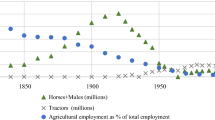Abstract
Rural areas of the developing world have become increasingly integrated into the world economy through both production and consumption during the last decades. This growing integration shapes the development of communities and influences their relationship to the natural environment. Where livelihoods are constrained by resource limitations and the productivity of labor in farm activities is low, it may result in a shift to nonfarm activities, which may under some conditions improve wellbeing and relieve pressure on natural resources. The possibility of such a “win-win” development pathway has important implications for development and environmental policy. In this article we use original qualitative and quantitative data to examine environmental and social changes during the last half century in a rural area of Morocco, seeking evidence of such a pathway. While our case study supports the hypothesis that nonfarm diversification in a context of resource scarcity allowed people to improve their material living conditions, the effects of economic integration and nonfarm diversification on the environment were mixed.



Similar content being viewed by others
Notes
This has changed in places where modern irrigated agriculture has been developed, mostly in the lower Sus plain, using groundwater and large quantities of inputs, but not in the study area, where agriculture has remained very traditional.
We named the villages A to E for privacy.
In 2007, with 21.5 % of the population under the poverty line of 3,569 MDH (Moroccan Dirhams, 1 USD = 8.5 MDH)/person*year, the commune was in the poorest fifth of all Moroccan communes (http://www.hcp.ma, last accessed 2012/09/10).
We observed cuts on live trees along 300 m transects whose origin and azimuth were generated randomly with a constant density of 1/1.5 km2. Each transect was divided into 10 equal-sized plots for which we noted the presence of cuts and of small argan trees that were cut in the past and developed close to the ground under grazing pressure (stunted trees).
We excluded one household with extremely high income due to French retirement money and the ownership of a building for rent in Casablanca. Three households forming a separate category were re-grouped a posteriori with the «local entrepreneurs» category based on their high local income.
Assuming 1 stere = 330 kg (Hansfort and Mertz 2011) and a standard calorific value of 4.5 kWh/kg wood.
References
Arnold, J. E. M., Köhlin, G., and Persson, R. (2006). Woodfuels, Livelihoods, and Policy Interventions: Changing Perspectives. World Development 34(3): 596–611.
Boudy, P. (1958). Economie Forestière Nord-Africaine. Larose, Paris.
Bryceson, D. (2002). The Scramble in Africa: Reorienting Rural Livelihoods. World Development 30(5): 725–739.
de Foucauld, C. (1888). Reconnaissance au Maroc. Challamel et Cie, Paris.
de Haas, H. (2006). Migration, Remittances and Regional Development in Southern Morocco. Geoforum 37(4): 565–580.
de Haas, H. (2010). Migration and Development: A Theoretical Perspective. International Migration Review 44(1): 227–264.
Haggblade, S., Hazell, P., and Reardon, T. (2010). The Rural Non-farm Economy: Prospects for Growth and Poverty Reduction. World Development 38(10): 1429–1441.
Hansfort, S. L., and Mertz, O. (2011). Challenging the Woodfuel Crisis in West African Woodlands. Human Ecology 39(5): 583–595.
Iiyama, M., Kariuki, P., and Kristjanson, P. (2008). Livelihood Diversification Strategies, Incomes and Soil Management Strategies: A Case Study from Kerio Valley, Kenya. Journal of International Development 397: 380–397.
Jokisch, B. D. (2002). “Migration and Agricultural Change: The Case of Smallholder Agriculture in Highland Ecuador”. Human Ecology 30(4).
le Polain de Waroux, Y., and Lambin, E. F. (2012). Monitoring Degradation in Arid and Semi-arid Forests and Woodlands: The Case of the Argan Woodlands (Morocco). Applied Geography 32(2): 777–786.
le Polain de Waroux, Y., and Lambin, E. F. (2013). Niche Commodities and Rural Poverty Alleviation: Contextualizing the Contribution of Argan Oil to Rural Livelihoods in Morocco. Annals of the Association of American Geographers 103(3): 589–607.
Matsumoto, T., Kijima Y., and Yamano T. (2006). “The Role of Local Non-farm Activities and Migration in Reducing Poverty : Evidence from Ethiopia, Kenya, and Uganda”. Agricultural Economics 35.
Noin, D. (1970). La population rurale du Maroc. Presses Universitaires de France, Paris.
Rigg, J. D. (2006). Land, Farming, Livelihoods, and Poverty: Rethinking the Links in the Rural South. World Development 34(1): 180–202.
Steward, A. (2007). Nobody Farms Here Anymore: Livelihood Diversification in the Amazonian Community of Carvão, a Historical Perspective. Agriculture and Human Values 24(1): 75–92.
Turner, B. (2009). Intervention Transnationale et Moralisation de la Gestion de la Propriété en Milieu Rural au Maroc. Anthropologica 51: 1–14.
UNESCO (2011). Biosphere Reserves in the Mountains of the World Excellence in the Clouds ? Austrian Academy of Science Press, Vienna.
Woods, M. (2007). Engaging the Global Countryside: Globalization, Hybridity and the Reconstitution of Rural Place. Progress in Human Geography 31(4): 485–507.
Author information
Authors and Affiliations
Corresponding author
Rights and permissions
About this article
Cite this article
le Polain de Waroux, Y., Chiche, J. Market Integration, Livelihood Transitions and Environmental Change in Areas of Low Agricultural Productivity: A Case Study from Morocco. Hum Ecol 41, 535–545 (2013). https://doi.org/10.1007/s10745-013-9607-7
Published:
Issue Date:
DOI: https://doi.org/10.1007/s10745-013-9607-7




